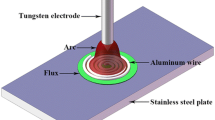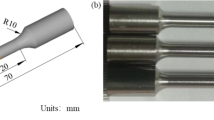Abstract
As an alternative to the traditional nickel-based filler metals, new-type iron-based filler metal has become a development trend for stainless steel brazing in exhaust gas recirculation (EGR) cooler fabrication, aiming at decreasing brazing temperature and obtaining higher joint strength with minimal erosion as well as better corrosion resistance. In particular, achieving the satisfying properties with inexpensive raw materials is desirable for broad industrial applications at an economic cost. A new type of iron-based filler metal was designed and developed for SUS304 stainless steel brazing. The effect of B and Mo content on interface microstructure, lap-joint shear strength, microhardness, and corrosion resistance of brazed seam was investigated. The optimum brazing parameters were achieved at 1050 °C-20 min. Both brazing temperature and holding time are critical factors for controlling the interface microstructure and hence the mechanical properties of the brazed joints. The interface microstructure and erosion of T-joints were observed and analyzed. Additionally, results from the evaluation on wettability, shear strength, and corrosion resistance have been benchmarked against commercial iron-based and nickel-based filler metals. Finally, tensile strength tests of brazed joint with developed iron-based filler metal in a form of paste and amorphous foil were conducted at both room temperature and high temperature.


















Similar content being viewed by others
References
Katsunori O, Shozo N. Iron-base heat-and corrosion-resistant brazing filler metals: Japan, EP2272619A1 [P], 2011-01-12
Bobzin K, Puidokas S, Tillmann W (2013) Reliable design procedure of iron-based braze joints, Proceedings of 10th International Brazing and Filler metaling Conference, Aachen, pp 261–266
Hartmann T, Nuetzel D (2009) New amorphous brazing foils for exhaust gas applications, Proc. 4th International Brazing and Filler metaling Conference, Orlando, AWS, pp 110–118
Pohlman MJ, Kindlimann LE Iron-based brazing alloy composition and brazed assemblies with iron based brazing alloys: USA, 4410604. 1983-10-18
Pouranvari M, Ekrami A, Kokabi H (2014) Diffusion brazing metallurgy of IN718/Ni-Cr-Si-B-Fe/IN718. Weld J 93:60s–68s
Hartmann T, Nuetzel D Iron-based brazing foil and method for brazing: USA, US2008/ 0318082A1. 2008-12-25
Hartmann T, Nuetzel D (2010) New amorphous brazing foils for exhaust gas applications. Proceedings of 9th International Brazing and Filler metaling Conference, pp 42–47
Rangaswamy SDJ Iron-based braze filler metal for high-temperature applications: USA, US2008/0006676A1. 2008-01-10
Jahanzeb N Erosion during brazing in stainless steel grade 304. Sweden, Hoganas, 2012–8
Weinstein M (2015) Properties of selected nickel and iron based brazing filler metals. Technical paper
Xiong HP et al A Fe-Ni-Cr system filler metal for brazing of stainless steel, China, CN201310541371.6. 2013-11-05
Owe M et al (2012) Erosion control of stainless steel brazing alloys, Proc. 5th International Brazing and Filler metaling Conference, Las Vegas, AWS.
Owe M et al Iron-chromium brazed filler metal: Sweden, EP2271460 B1, 2011-11-16
Iron-based brazing filler metal-BrazeLet ® F300 product datasheet, Höganäs Company, 2014
Tillmann W, Wojarski L, Manka M et al (2016) Investigation of the brazing characteristics of a new iron-based brazing filler metal. Welding in the World 60(5):869–875
High-temperature characteristics of stainless steels, A Designers' Handbook Series No. 9004, American Iron and Steel Institute, 2011
Shi KD Study on Fe-Cr-based brazing filler metals as substitutes for Ni-based brazing filler metals. Japan, Gunma University, 2016–8
Acknowledgements
We thank Ms. Yunyue Li for assistance with DSC curve measurement and Prof. Jacek Senkara of Warsaw University of Technology for comments that greatly improved the manuscript.
Funding
This research was supported International Ability Improvement of Young Supervisor Project (2017-2019) and International Seed Fund for Science and Technology Cooperation Project (2018-2019) funded by BJUT.
Author information
Authors and Affiliations
Corresponding author
Additional information
Recommended for publication by Commission XVII - Brazing, Soldering and Diffusion Bonding
Rights and permissions
About this article
Cite this article
Li, H., Zhang, X., Mårs, O. et al. The effect of iron-based filler metal element on the properties of brazed stainless steel joints for EGR cooler applications. Weld World 63, 263–275 (2019). https://doi.org/10.1007/s40194-018-00687-9
Received:
Accepted:
Published:
Issue Date:
DOI: https://doi.org/10.1007/s40194-018-00687-9




